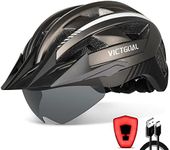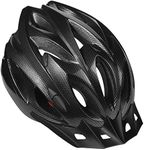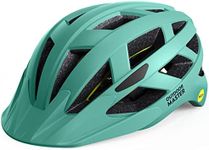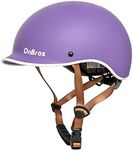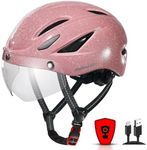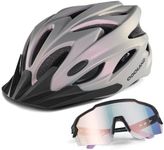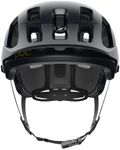Buying Guide for the Best Bicycle Helmets
Choosing the right bicycle helmet is essential for your safety and comfort while riding. A good helmet not only protects your head in case of a fall or collision, but also ensures you feel comfortable enough to wear it every time you ride. When shopping for a helmet, it's important to consider how and where you'll be riding, as well as your personal preferences for fit, ventilation, and style. Understanding the key features will help you make a choice that keeps you safe and happy on your bike.Fit and SizeFit and size refer to how well the helmet sits on your head. This is the most important aspect because a helmet that doesn't fit properly won't protect you as intended. Helmets come in different sizes, usually measured by head circumference in centimeters. To find your size, measure around your head just above your eyebrows. Helmets often have adjustable straps and dials to fine-tune the fit. A good fit means the helmet is snug but not uncomfortable, doesn't move when you shake your head, and sits level on your head. If you ride often or for long periods, prioritize comfort and adjustability.
Safety CertificationsSafety certifications indicate that the helmet meets certain safety standards set by organizations like CPSC, EN, or ASTM. These standards ensure the helmet can absorb impact and protect your head in a crash. Always check for a certification label inside the helmet. All helmets sold in reputable stores should meet at least one standard, but if you ride in different countries, make sure the helmet meets the local requirements. For most riders, any certified helmet will provide adequate protection, but knowing your helmet is certified gives peace of mind.
VentilationVentilation refers to the number and size of vents in the helmet, which allow air to flow over your head and keep you cool. More vents generally mean better airflow, which is important for long rides or hot weather. However, more vents can sometimes mean less coverage or slightly less protection. If you ride in warm climates or do intense cycling, look for helmets with plenty of large vents. For casual or short rides, ventilation may be less critical.
WeightWeight is how heavy the helmet feels on your head. Lighter helmets are more comfortable, especially for long rides, as they put less strain on your neck. Most modern helmets are fairly lightweight, but there are differences. If you plan to ride for hours or do competitive cycling, a lighter helmet can make a noticeable difference. For short, casual rides, weight is less of a concern.
Retention SystemThe retention system is the mechanism that helps keep the helmet securely on your head, usually involving straps and an adjustable dial at the back. A good retention system allows you to easily adjust the fit for comfort and security. Some systems are more advanced and allow for one-handed adjustment while riding. If you value convenience and a perfect fit, look for helmets with a high-quality, easy-to-use retention system.
Shell and Liner MaterialThe shell is the hard outer layer, and the liner is the foam inside that absorbs impact. Most helmets use a polycarbonate shell and an EPS foam liner, which provide a good balance of protection and weight. Some helmets use additional materials or technologies for extra protection, like MIPS (Multi-directional Impact Protection System), which helps reduce rotational forces in certain impacts. If you want the latest in safety technology, look for helmets with these added features, but for most riders, standard materials are sufficient.
Style and CoverageHelmets come in different styles, such as road, mountain, commuter, or full-face. The style affects the shape, coverage, and features. Road helmets are lightweight with lots of vents, mountain bike helmets offer more coverage at the back and sides, and commuter helmets often have a more casual look and may include features like built-in lights. Choose a style that matches your typical riding environment and personal preference. More coverage is better for off-road or aggressive riding, while lighter, more ventilated helmets suit road cycling.
